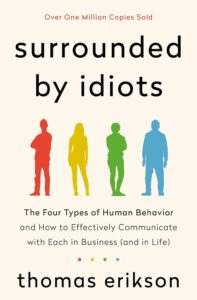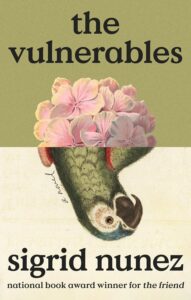Pete’s Pick
April 2024
The Librarian of Burned Books: A Novel
Brianna Labuskes
Historical Fiction
William Morrow Publishing, February 21, 2023
Introduction
This novel is about the role that books have played in politics, particularly world politics, as well as the incredible historical significance that efforts to ban books from libraries and bookstores has played in world history and is now playing out in our own history here in the United States of America in the 21st century.
Author
Brianna Labuskes is a Wall Street Journal, Washington Post, and Amazon Charts bestselling author of psychological thrillers and historical fiction. She was born in Harrisburg, PA, grew up in Pennsylvania, and graduated from Penn State Unversity with a degree in journalism. For several years, she was a journalist for national new organizations covering politics and policy. She lived in Washington, DC for many years and now calls Asheville, NC home.
Story
This story opens in late 1943 with one of the main characters, Vivian Childs, receiving a telegram that her husband had been killed in action during World War II. It immediately moves to a scene in May 1944 where Viv is crashing a luncheon in NYC being hosted by Senator Robert Taft of Ohio. Viv is working for the Council on Books in Wartime, which distributed paperback books to American servicemen through a program called American Service Editions. The were deliberately designed to be a size that fit into the breast pockets of the uniforms worn by American servicemen and were intended to give them something to read in their downtime from whatever their wartime mission was. Senator Taft had drafted an amendment to the Soldiers Voting Act of 1944 which had been passed by Congress and which would ban about 90 percent of the books the Council on Books in Wartime wanted to send out as ASEs. This included books like The Adventures of Huckleberry Finn and Grapes of Wrath. Viv’s goal was to raise public awareness of the censoring Senator Taft’s amendment permitted and cause an outcry that would cause the amendment to be overturned in Congress.
The story next moves on to Berlin in 1933 and introduces us to three women who become central characters as the story unfolds. Althea James is a young woman author from the coast of Maine who has recently written a best-selling novel. Deveraux Charles (Dev) is an upcoming American actress, movie director, and play writer. Althea and Dev are guests of the German government under Joseph Goebble’s Cultural Ministry program to acquaint American talent with Germany during a six-month internship. Hannah Brecht is a German Jewish woman living in Berlin during this time. The story unfolds as Adolph Hitler comes to power as the Chancellor of Germany and begins his Third Reich initiative. The story next moves to Paris in 1936 as the French people are becoming concerned about Hitler’s regime in Germany and the potential for war to occur. Hannah is the main character we follow in Paris as she works in the Library of Banned Books, a library built to house the books that were burned in Berlin in May 1933 during the incredible book-burning saga. The purpose of the library is to preserve the sanctity of these books that had been banned for political purposes.
The novel takes us back and forth between 1944 when Viv is waging a fight for have Senator Tafts’s amendment of the Soldier Voting Act of 1944 overturned so that books are not banned from the ASE program just because they represent views that conservatives find offensive, 1933 when Althea, Dev, and Hannah are in Berlin during the initial days of Hitler’s regime building and the book banning being carried out there, and 1936 when Hannah is in Paris working at the Library of Burned Books and is experiencing the rising apprehension of the French people to what is happening in the world with Hitler’s growth in power and his desire to take control of Europe.
A lot of the story line is about the prevalence of a pretty active gay culture in Europe during the 1930s and 1940s. It is contrasted with the growth of a German political regime which seeks to weed out everything that would detract from the great Aryan mindset and the tension in all of society about activities and pastimes which are not appropriate. The focus in America in the 1940s is on trying to control what books are appropriate for distributing to American servicemen through the ASE program and who gets to decide what is appropriate. The tension brings us very much into today’s environment of the early 21st century as we are again fighting a battle over who controls what types of books are available in our school and public libraries and what sort of behaviors are portrayed in the books which school boards and township councils seek to remove from our libraries and classrooms.
Evaluation
I found myself pretty caught up in the broad story line that people in positions of power feel they need to control the kinds of books and reading material that are available to students and the public in order to control they kinds of things they think about. That’s what censorship is about, right? Someone in authority gets to decide what is appropriate to read or watch. I confess I was unaware of the 1940s effort by Senator Robert Taft of Ohio to control the kind of reading material made available to American servicemembers during WWII through the ASE program. In fact, I guess I wasn’t really aware of the ASE program until I read this book. It certainly hit home given the current situation we are dealing with even now in Hunterdon County as the North Hunterdon High and Voorhees High School Board deals with an effort to ban certain types of reading material from the schools’ libraries.
I learned a lot reading this book and am now on edge as I watch what is happening in my own community.
Surrounded by Idiots:
The Four Types of Human Behavior and How to Effectively Communicate with Each in Business (and in Life)
Thomas EriksonSt. Martin’s Essentials Press
After interviewing a successful CEO who was convinced he was “surrounded by idiots”, author Thomas Erikson dedicated himself to understanding how people function and why we often struggle to connect with certain types of people.
“Surrounded by Idiots” explains a method for assessing the personalities of people we communicate with, based on four key human behaviors that define how we interact with, and how we perceive each other. Erikson says in a perfect world every working scenario would include all four personality types. The Yellow (Inspiring) personality would come up with the project idea, Red (Dominant) would make the decisions and delegate tasks, the Green (Stable) personality would execute the plan, and Blue (Analytical) would supervise for quality control.
However, since it would be nearly impossible to find a situation with perfectly balanced personality types, Erikson suggests we learn to understand how best to communicate with each other.
A brief synopsis of each color:
Red Personalities are ambitious, aggressive, strong-willed, controlling; they are the “alpha” in the room. To communicate with a Red you must be sincere and direct; Reds hate beating around the bush and are uninterested in “small talk” when trying to accomplish something.
Yellow Personalities are talkative, creative, persuasive, and optimistic. Social beings, Yellows do not like to be isolated, or surrounded by negative energy. They are most receptive if you are open and friendly.
Green Personalities are patient, friendly, reliable, thoughtful team players, but have minimal interest in change. Greens like privacy, and don’t care to be in the spotlight. They also may have fragile egos, and don’t respond well to a sudden change in plans.
Blue Personalities are conscientious, analytical, conventional, logical, and questioning. Detail-oriented, have your facts and arguments prepared beforehand when communicating with a Blue.
The idea of four distinctive behavior types is far from a new concept. This same hypothesis can be traced back, for example, to Hippocrates, who categorized the personality types into sanguine, choleric, phlegmatic, and melancholic. The Aztecs offered Fire, Air, Water, and Earth to define behavior. In the 20th century, the “DISA system” was developed by Walter Marston (Dominance, Inspiration, Stability, and Analytic ability). Erikson has simplified the four behaviors into Red, Yellow, Green, and Blue. Throughout history, the four categories remain nearly identical.
Erikson is quick to explain that it is a truly rare person who is just one behavior type. Eighty percent of people are two types; a small percentage three types.
This book is a far cry from what I would normally choose to review in this forum. Designed for human resource workers and managers within the workplace, it seems an unusual fit for me.
But, in fact, I think the book is a great tool for both self-awareness and for learning to perceive the dynamics within groups we associate with. With my own extended family, we often shake our heads and exclaim “I can’t believe how different we are!” The differences, it turns out, are not in our values or principles, but in our innate behavior profiles. Any book that can have me step back and reassess, allowing for some understanding of, and better communication with, people I love is worth the read for me.
The Vulnerables
Sigrid Nunez
Riverhead Books, November 7, 2023
The Vulnerables is a literary novel by Sigrid Nunez, the 2018 National Book Award winner for The Friend. This book is at the same time both grim and joyful, and, as in The Friend, has a stressful plot, uber angst-filled characters, and an animal.
Nunez has a writing style that is always fluid and engaging but at times, in The Vulnerables, it is a bit convoluted and jumpy. Perhaps this was her way to represent the trying environment about which the book was written. The plot is focused on the pandemic; in essence it is a COVID diary, identifying the all-too-familiar details and the trepidation of daily living.
Nunez's characterizations are wonderful. The unnamed narrator of the book is a 65-year-old struggling woman writer, identified as a CDC venerable who agrees to housesit a parrot in a friend's luxury New York City apartment. This arranged companionship is a comfort for both the narrator and bird. They spend hours together just watching and learning about each other… “he could hardly have been more grateful for my company than I was for his. I woke up every day looking forward to the simple chore”. This was just the sense of harmony she needed.
Nunez disrupts the harmony by introducing an aimless GenZ man named Vetch (like the weed). He appears unexpectedly in the apartment wanting his job back as (he was the first) parrot-sitter. She discovers he's the irresponsible kid who “flew the coop to be with friends in Vermont”. The narrator tells the reader “He's flaky and unfocused and everything about his presence in the apartment-- his messiness! his casual good looks! his testosterone! irritates her.” He won't leave. She won't leave either. So, they are stuck with each other, trying their best to avoid any interaction.
… And then there's the handsome and talented parrot named Eureka. Eureka, the narrator tells us, is “a curb against misanthropy, into which these days is all too easy to fall”. The passages about the parrot are funny and heartfelt.
Initially, the narrator and Vetch dance around each other to avoid crossing paths in the apartment. Not eating at the same time, different waking schedules, one-word responses to comments. However, neither seem satisfied with this situation. The caretakers anthropomorphizing of Eureka provides them with the basis for a warming relationship.
In most situations, it would be highly unlikely for these three characters to be thrown together. The Vulnerables reminds us what can happen when strangers who are forced to be together are willing to trust, learn, and emotionally share with each other.
Most of us would be happy to erase the imposed lifestyle changes we had to make as we tiptoed during the pandemic years, and the discomfort we felt most of the time. I found this book to be strangely hopeful by reinforcing personal decisions we made when we decided to move on. Reading Nunez’s The Vulnerables puts our focus on the importance of small acts of kindnesses that can help to allay fears and offer strength.
NOTE: I truly appreciated being reminded that we can all be “vulnerables”. I highly recommend this book.
A Fever in the Heartland: The Ku Klux Klan’s Plot to Take Over America, and the Woman Who Stopped Them
Timothy Egan
Viking Press, April 2, 2023
I love history. Not surprisingly, historical fiction is probably the category I read the most of. The reader can see, based on author notes and bibliographies, how much effort has been taken for any real events to be represented accurately. There is a subclass of superb authors who are able to take historical material, such as court transcripts and newspaper articles, and combine it to create a compelling narrative (think Erik Larson and The Devil in the White City or David Grann for Killers of the Flower Moon or The Wager). Timothy Egan belongs in this class.
I don’t believe I ever knew that the Ku Klux Klan existed anywhere other than the South, as its name was usually paired with lynchings of escaped slaves or impudent teenagers. So, the long descriptive title of this book intrigued me–and then the doings of con man D.C. Stephenson disgusted me. Stephenson was a well-spoken huckster whose life story changed each time he told it. After observing the lifestyle of several Klansmen, he wanted to become part of the organization. He brought membership in the Klan out of the shadows. When powerful men in an Indiana town joined, other citizens would also do so just to curry favor with them. And each member would be expected to buy a robe and other gear, which Stephenson received a cut of.
Stephenson was clever in that he created Klan groups for women and children, and by bribing local clergy with a donation for whatever their pet project was, the reverends would preach the Klan’s virtues from the pulpit–even as the KKK’s doings diverged wildly from Christian values. And unbeknownst to most of his new converts, Stephenson was a serial predator of young women and did reprehensible things that somehow got covered up.
And “the woman who stopped them”? Madge Oberholtzer was a thoroughly modern young woman who traveled cross country alone by auto and lived her life as she pleased. When she first met Stephenson, she didn’t think much of him, but he seemed interested in her work so she maintained a casual friendship. One evening he asked her to come by his house, and she did. She had no idea how awful this decision would be. She made it back to her parents’ house but remained weak. At this point a lawyer was hired to question her as if she were testifying against Stephenson at trial for the attack. After she completed the deposition, she died. Such a pity, but kudos to the family to clear her name and send Stephenson to prison.
This book is compelling and a heart-stopping read in places. I for one will be checking out the author’s other books.


